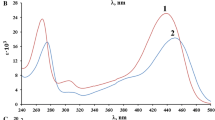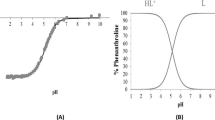Abstract
Time stability, acid-base and UV-VIS spectral properties of dihydrochelerythrine (DHCHE) were studied spectrophotometrically in water:methanol and water:ethanol media. DHCHE is stable in strongly acid milieu (pH < 3) and at the higher amounts (60% v/v) alcohol. Acid-base characteristics and UV-VIS spectral properties of chelerythrine (CHE) were studied in aqueous solutions in the presence of different concentrations of HCl, HNO3, H2SO4, H3PO4 and their mixtures. Remarkable shifts of formation parts of absorbance-pH (A-pH) curves to the alkaline medium were observed depending on the type and concentration of inert electrolyte (most remarkable for HNO3 and HCl). The corresponding equilibrium constants pKR+ of the transition reaction between charged iminium Q+ and uncharged QOH (pseudo-base, 6-hydroxy-dihydro derivative) forms of chelerythine were calculated using a numerical interpretation of A-pH curves by a SQUAD-G computer program which ranged from 8.51–9.31. The highest changes of ΔpK R+ (0.75 and 0.53) were observed for H3PO4 and H2SO4, respectively. The priority effect of ionic species and ionic strength was confirmed in the presence of additions of NaCl and KCl. The strength of interaction of CHE with biomacromolecular compounds (i.e., peptides, proteins, nucleic acids etc.) may be affected because of the observed influence of both cation and anion of the inert electrolyte on acid-base behavior.

Similar content being viewed by others
References
V. Šimánek, in: A. Brossi (Ed.), The Alkaloids (Academic Press, Orlando, 1985) 26, 185
J. Psotová et al., J. Chromatogr. B., Analyt. Technol. Biomed. Life Sci. 830, 427 (2006)
M. Maiti, G.S. Kumar, Med. Res. Rev. 27, 649 (2007)
R. Sinha, M. Hossain, G.S. Kumar, DNA Cell Biol. 28, 209 (2009)
J. Urbanová, P. Lubal, I. Slaninová, E. Táborská, P. Táborský, Anal. Bioanal. Chem. 394, 997 (2009)
I. Slaninová, J. Slanina, E. Táborská, Chem. Listy 102, 427 (2008) (in Czech)
Z. Dvořák et al., Heterocycles 68, 2403 (2006)
M. Janovská, M. Kubala, V. Šimánek, J. Ulrichová, Anal. Bioanal. Chem. 395, 235 (2009)
J. Dostál, J. Slavík, In: Atta-ur-Rahman (Ed.) Studies in Natural Products Chemistry, (Elsevier, Amsterdam, 2002) 27, 155
M. Vlčková, J. Barták, V. Kubáň, J. Chromatogr. A 1040, 141 (2004)
M. Vlčková, V. Kubáň, J. Vičar, V. Šimánek, Electrophoresis 26, 1673 (2005)
R. Vespalec, M. Vlčková, H. Horáková, J. Chromatogr. A 1051, 75 (2004)
I.G. Motevich, N.D. Strekal, J.W. Nowicky, S.A. Maskevich, J. Appl. Spectrosc. 74, 666 (2007)
P. Giri, G.S. Kumar, Biochim. Biophys. Acta 1770, 1419 (2007)
K. Bhadra, M. Maiti, G.S. Kumar, DNA Cell Biol. 27, 675 (2008)
E. Vrublová et al., J. Food Chem. Toxicol. 46, 2546 (2008)
H. Absolínová, L. Jančář, I. Jančářová, J. Vičar, V. Kubáň, Cent. Eur. J. Chem. 7, 876 (2009)
Author information
Authors and Affiliations
Corresponding author
About this article
Cite this article
Absolínová, H., Jančář, L., Jančářová, I. et al. Spectrophotometric study of time stability and acid-base characteristics of chelerythrine and dihydrochelerythrine. cent.eur.j.chem. 8, 626–632 (2010). https://doi.org/10.2478/s11532-010-0038-7
Received:
Accepted:
Published:
Issue Date:
DOI: https://doi.org/10.2478/s11532-010-0038-7




